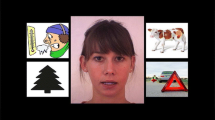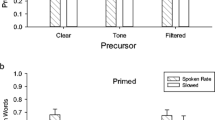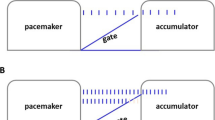Abstract
The purpose of the present study was to examine effects of time pressure on mechanisms of speech production and self-monitoring. The most widely accepted monitoring theory (Levelt, 1989) suggests that monitoring proceeds through language perception, that is, speech error detection is primarily based on the parsing of one's own inner and overt speech. Twenty-four subjects described visual networks at two different rates (normal and fast). The time pressure manipulation affected a number of temporal characteristics: the error to cutoff and cutoff to repair times were shorter in the fast than in the normal condition. The results indicate that the monitor adjusts its speed of error detection and repair planning to the faster speech output rate. The time pressure manipulation did not affect the accuracy of error detection. The implications for the perception theory of monitoring are discussed.
Similar content being viewed by others
REFERENCES
Baddeley, A. D., & Hitch, G. (1974). Working memory. In G. A. Bower (Ed.), The psychology of learning and motivation (pp. 47-89). New York: Academic Press.
Berg, T. (1986). The aftermath of error occurrence: psycholinguistic evidence from cut offs. Language and Communication, 6, 195-213.
Blackmer, E. R., & Mitton, J. L. (1991). Theories of monitoring and the timing of repairs in spontaneous speech. Cognition, 39, 173-194.
Brédart, S. (1991). Word-interruption in self-repairing. Journal of Psycholinguistic Research, 20, 123-138.
Christenfeld, N. (1994). Options and ums. Journal of Language and Social Psychology, 13, 192-199.
Clark, H. H., & Clark, E. (1977). Psychology and Language.An Introduction to Psycholinguistics. Harcourt, New York.
Clark, H. H., & Wasow, W. (1998). Repeating words in spontaneous speech. Cognitive Psychology, 37, 201-242.
Dell, G. S. (1986). A spreading activation theory of retrieval in sentence production. Psychological Review, 93, 124-142.
Dell, G. S. (1990). Effects of frequency and vocabulary type on phonological speech errors. Language and Cognitive Processes, 5, 313-349.
Dell, G. S., & Repka, R. J. (1992). Errors in inner speech. In B. J. Baars (Ed.), Experimental slips and human error: Exploring the architecture of volition. New York: Plenum Press.
De Smedt, K., & Kempen, G. (1987). Incremental sentence production, self-correction and coordination. In G. Kempen (Ed.), Natural language generation (pp. 365-376). Dordrecht: Martinus Nijhoff.
Feldstein, S, Crown, C. L., & Jaffe, J. (1991). Expectation and extraversion: influencing the perceived rate of tone-silence sequences. Bulletin of the Psychonomic Society, 29, 395-398.
Garnsey, S. M., & Dell, G. S. (1984). Some neurolinguistic implications of prearticulatory editing in production. Brain and Language, 23, 64-73.
Gathercole, S. E., & Baddeley, A. D. (1993). Working memory and language. Hillsdale, NJ: Erlbaum.
Goldman-Eisler, F. (1968). Psycholinguistics: Experiments in spontaneous speech. New York: Academic Press.
Grosjean, F., & Lane, H. (1981). Temporal variables in the perception and production of spoken and sign languages. In P. D. Eimas & J. L. Miller(Eds.), Perspectives in the study of speech (pp. 207-238). Hillsdale, NJ: Erlbaum.
Hartsuiker, R. J., & Kolk, H. H. J. (in press). Error monitoring in speech production: a computational test of the perceptual loop theory. Cognitive Psychology.
Henderson, A. I. (1974). Time patterns in spontaneous speech-cognitive stride or random walk? A reply to Jaffe et al. (1972). Language and Speech, 17, 119-125.
Howell, P., Kadi-Hanifi, K., & Joung, K. (1991). Phrase revisions in fluent and stuttering children. In H. M. Peters, W. Hulstijn, & C. W. Starkweather (Eds.), Speech motor control and stuttering. Amsterdam: Elsevier.
Jaffe, J., Anderson, S. W., & Rieber, R. W. (1973). Research and clinical approaches to disorders of speech rate. Journal of Communication Disorders, 6, 225-246.
Kempen, G. (submitted). Human Grammatical Coding. Book manuscript.
Kempen, G., & Hoenkamp, E. (1987). An incremental procedure grammar for sentence formulation. Cognitive Science, 11, 201-258.
Kemper, S. (1992). Adults' sentence fragments: who, what, when, where, and why? Communication Research, 19, 444-458.
Klapp, S. T., Anderson, W. G., & Berrian, R. W. (1973). Implicit speech in reading, reconsidered. Journal of Experimental Psychology, 100, 368-374.
Klapp, S. T., & Erwin, C. I. (1976). Relation between programming time and duration of the response being programmed. Journal of Experimental Psychology: Human Perception and Performance, 2, 59-598.
Kowall, S., O'Connell, D. C., & Sabin, E. J. (1975). Temporal patterning and vocal hesitations in spontaneous narratives. Journal of Psycholinguistic Research, 4, 195-204.
Lackner, J. R., & Tuller, B. H. (1979). Role of efference monitoring in the detection of selfproduced speech errors. In W. E. Cooper & E. C. T. Walker(Eds.), Sentence processing (pp. 281-294). Hillsdale, NJ: Erlbaum.
Laver, J. D. M. (1980). Monitoring systems in the neurolinguistica control of speech production. In V. A. Fromkin (Ed.), Errors in linguistic performance: Slips of the tongue, ear, pen, and hand (pp. 287-305). New York: Academic Press.
Levelt, W. J. M. (1983). Monitoring in self-repair in speech. Cognition, 14, 41-104.
Levelt, W. J. M. (1989). Speaking: From intention to articulation. Cambridge, MA: MIT Press.
Levelt, W. J. M. (1992). The perceptual loop theory not disconfirmed: A reply to MacKay. Consciousness and Cognition, 1, 226-230.
Levelt, W. J. M., Roelofs, A., & Meyer, A. S. (1999). A theory of lexical access in speech production. Behavioral and Brain Sciences, 22, 1-37.
MacKay, D. G. (1982). The problems of flexibility, fluency, and speed-accuracy trade-off in skilled behavior. Psychological Review, 89, 483-506.
MacKay, D. G. (1987). The organization of perception and action: A theory for language and other cognitive skills. New York: Springer.
MacKay, D. G. (1992a). Errors, ambiguity, and awareness in language perception and production. In B. J. Baars(Ed.), Experimental slips and human error: Exploring the architecture of volition. New York: Plenum Press.
MacKay, D. G. (1992b). Awareness and error detection: New theories and research paradigms. Consciousness and Cognition, 1, 199-225.
Marslen-Wilson, W., & Tyler, L. (1981). Central processes in speech understanding. Philosophical Transactions of the Royal Society London, B259, 317-332.
Martin, N., Weisberg, R. W., & Saffran, E. M. (1989). Variables influencing the occurrence of naming errors: implications for models of lexical retrieval. Journal of Memory and Language, 28, 462-485.
Miller, J. L., Grosjean, F., & Lomanto, C. (1984). Articulation rate and its variability in spontaneous speech: a reanalysis and some implications. Phonetica, 41, 215-225.
Miyake, A., Carpenter, P. A., & Just, M. A. (1995). Reduced resources and specific inpairments in normal and aphasic sentence comprehension. Cognitive Neuropsychology, 12, 651-679.
Motley, M. T. (1980). Verification of "Freudian slips" and semantic prearticulatory editing via laboratory-induced spoonerisms. In V. A. Fromkin (Ed.), Errors in linguistic performance: Slips of the tongue, ear, pen, and hand. New York: Academic Press.
Motley, M. T., Camden, C. T., & Baars, B. J. (1982). Covert formulation and editing of anomalies in speech production: Evidence from experimentally elicited slips of the tongue.Journal of Verbal Learning and Verbal Behavior, 21, 578-594
Norman, D. A., & Shallice, T. (1986). Attention to action: Willed and automatic control of behavior. In R. J. Davidson, G. E. Schwarts, & D. Shapiro (Eds.), Consciousness and Self-Regulation, Vol. 4 (pp. 1-18). London: Wiley.
Postma, A. (2000). Detection of Errors during Speech Production: A Review of Speech Monitoring Models. Cognition, 77, 97-131.
Postma, A., & Kolk, H. H. J. (1992). The effects of noise masking and required accuracy on speech errors, disfluencies, and self-repairs. Journal of Speech and Hearing Research, 35, 537-544.
Postma, A., & Kolk, H. H. J. (1993). The covert repair hypothesis: prearticulatory repair processes in normal and stuttered disfluencies. Journal of Speech and Hearing Research, 36, 472-487.
Postma, A., Kolk, H., & Povel, D. J. (1990). On the relation among speech errors, disfluencies, and self-repairs. Language and Speech, 33, 19-29.
Postma, A., & Noordanus, C. (1996). The production and detection of speech errors in silent, mouthed, noise-masked, and normal auditory feedback speech. Language and Speech, 39, 375-392.
Schlenck, K. J., Huber, W., & Willmes, K. (1987). Prepairs and repairs: different monitoring functions in aphasic language production. Brain and Language, 30, 226-244.
Shriberg, E. E. (1994). Preliminaries to a theory of speech disfluencies. Unpublished doctoral dissertation.
Van Hest, G. W. C. M. (1996). Self-repair in L1 and L2 production. In R. Appel, G. Extra, K. Jaspaert, & L. Verhoeven (Eds.), Studies in multilingualism, Vol. 4, Tilburg: University Press.
Van Wijk, C., & Kempen, G. (1987). A dual system for producing self-repairs in spontaneous speech: evidence from experimentally elicited corrections. Cognitive Psychology, 19, 403-440.
Wheeldon, L. R., & Levelt, W. J. M. (1995). Monitoring the time course of phonological encoding. Journal of Memory and Language, 34, 311-334.
Author information
Authors and Affiliations
Rights and permissions
About this article
Cite this article
Oomen, C.C.E., Postma, A. Effects of Time Pressure on Mechanisms of Speech Production and Self-Monitoring. J Psycholinguist Res 30, 163–184 (2001). https://doi.org/10.1023/A:1010377828778
Issue Date:
DOI: https://doi.org/10.1023/A:1010377828778




